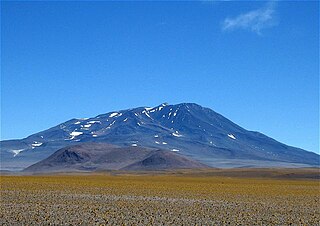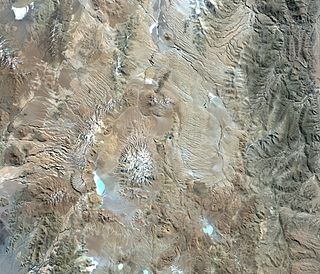 W
WAgua Poca is a monogenetic volcano in the Puelén Department of Argentina. The volcano has the form of a cinder cone and has been active in the Pleistocene.
 W
WThe Andean Volcanic Belt is a major volcanic belt along the Andean cordillera in Argentina, Bolivia, Chile, Colombia, Ecuador, and Peru. It is formed as a result of subduction of the Nazca Plate and Antarctic Plate underneath the South American Plate. The belt is subdivided into four main volcanic zones which are separated by volcanic gaps. The volcanoes of the belt are diverse in terms of activity style, products, and morphology. While some differences can be explained by which volcanic zone a volcano belongs to, there are significant differences within volcanic zones and even between neighboring volcanoes. Despite being a type location for calc-alkalic and subduction volcanism, the Andean Volcanic Belt has a broad range of volcano-tectonic settings, as it has rift systems and extensional zones, transpressional faults, subduction of mid-ocean ridges and seamount chains as well as a large range of crustal thicknesses and magma ascent paths and different amounts of crustal assimilations.
 W
WAntofagasta de la Sierra is a volcanic field in Argentina. The main type of volcanic edifice in the area are scoria cones, it is formed by the La Laguna, Jote and Alumbrera volcanoes. The first and last of these form a sub-group which is better researched. Various dating methods have yielded ages from several million to several hundred thousand years ago, but some vents appear to be of Holocene age.
 W
WArizaro volcanic field is a group of volcanoes west of the Salar de Arizaro
 W
WCerro Beltrán is an andesitic-dacitic volcano in the Andes. It erupted andesitic-dacitic lava flows between 14.1 and 7.7 mya. Based on geochemical considerations, the volcano formed from granite and plagioclase bearing, 33–40 kilometres (21–25 mi) thick crust. Part of the volcano was later covered by ignimbrites coming from the Galán caldera eruption.
 W
WCerro Bonete is a mountain in the north of the province of La Rioja, Argentina, near the provincial border with Catamarca. Its summit is 6,759 m above mean sea level, making it the fifth-highest separate mountain in the Americas. SRTM data disproves the frequently-made claim that its summit is 6,872 m above sea level.
 W
WCueros de Purulla is a volcano in Argentina. It consists of a lava dome and an associated ignimbrite. A large eruption dated to c. 7820 BP deposited ash into the Valles Calchaquies.
 W
WCerro Galán is a caldera in the Catamarca Province of Argentina. It is one of the largest exposed calderas in the world and forms part of the Central Volcanic Zone of the Andes, one of the three volcanic belts found in South America. One of several major caldera systems in the Central Volcanic Zone, the mountain is grouped into the Altiplano–Puna volcanic complex.
 W
WSierra Nevada, also known as Sierra Nevada de Lagunas Bravas, is a major ignimbrite-lava dome complex which lies in both Chile and Argentina in one of the most remote parts of the Central Andes. Activity in the complex started in Argentina and formed two stratovolcanoes. Later, 12 or more vents formed, some with craters up to 400 metres (1,300 ft) wide. Lava flows up to 7 kilometres (4.3 mi) long with flow ridges are also found. It covers a total area of 225 km². Radiometric dating has yielded ages of 1.7 ± 0.4 to 0.431 ± 0.012 million years ago. Together with Cerro el Condor and Peinado it forms the Culampaja line, a line of volcanoes that reaches Cerro Blanco. Strong seismic attenuation is observed beneath Sierra Nevada. Hydrothermally altered rocks in Sierra Nevada may be the source of sulfate and As in the Juncalito and Negro rivers.
 W
WCumbre de la Majadita is a mountain peak in the province of San Juan in Argentina near the town of Rodeo. It was one of the last 6000m+ peaks in the Andes to be climbed, the first recorded ascent being in December 1996.
 W
WCerro Mercedario is the highest peak of the Cordillera de la Ramada range and the eighth-highest mountain of the Andes. It is located 100 km to the north of Aconcagua, in the Argentine province of San Juan. It was first ascended in 1934 by Adam Karpiński and Wiktor Ostrowski, members of a Polish andinist expedition led by Konstanty Jodko-Narkiewicz. The Polish party erected a cairn on the summit.
 W
WNegra Muerta is a caldera in Argentina. It is part of the volcanic centres of the Andean Volcanic Belt, which has formed a number of calderas in large ignimbrite producing eruptions. These calderas include Aguas Calientes, Cerro Panizos, Galan, Negra Muerta and La Pacana. Some of these volcanic centres appear to be associated with large fault zones that cross the Puna.
 W
WPasto Ventura is an area in the Catamarca Province of Argentina. It features about 14 small Pleistocene volcanoes, mostly cinder cones with associated lava flows but also lava domes, tuff rings and two maars. The volcanoes are accompanied by pyroclastic deposits and their total volume reaches about 0.42 cubic kilometres (0.10 cu mi). Argon-argon dating has yielded ages ranging from 1.3 million years to about 270,000 years for volcanic rocks in the field.
 W
WPuesto Cortaderas is an isolated basaltic pyroclastic cone in Neuquén Province, Argentina.
 W
WNevado San Francisco, or Cerro San Francisco, is a stratovolcano on the border between Argentina and Chile, located just southeast of San Francisco Pass. It is considered extinct and is one of the several 6,000 m (19,700 ft) peaks in the area, of which the chief is the Ojos del Salado.
 W
WVilama is a Miocene caldera in Bolivia and Argentina. Straddling the border between the two countries, it is part of the Central Volcanic Zone, one of the four volcanic belts in the Andes. Vilama is remote and forms part of the Altiplano-Puna volcanic complex, a province of large calderas and associated ignimbrites that were active since about 8 million years ago, sometimes in the form of supervolcanoes.